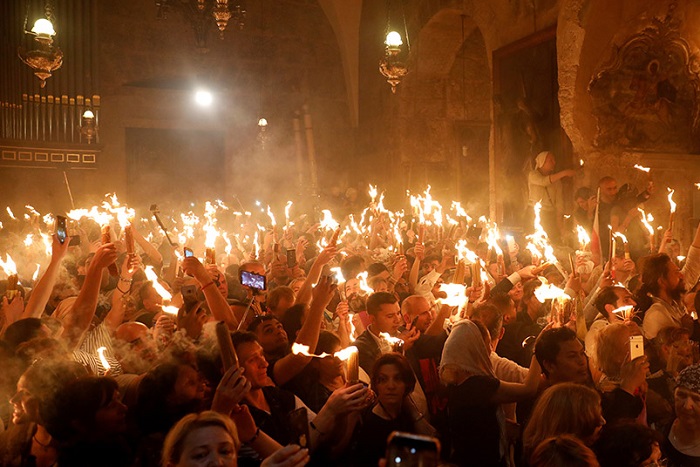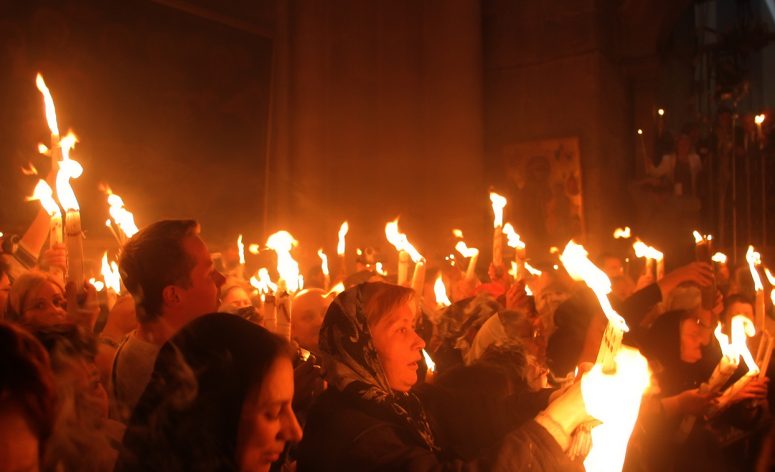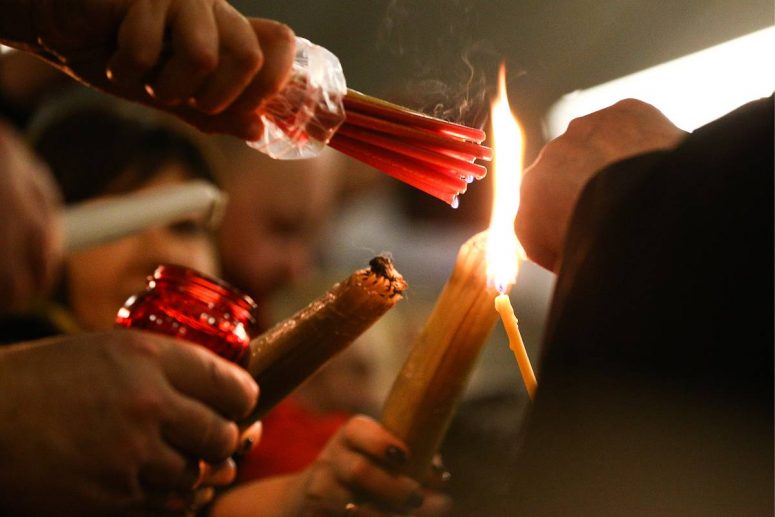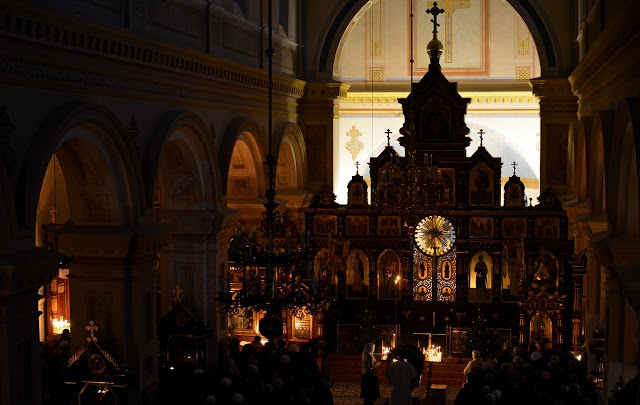
The so-called “Holy Fire” is the name given to the fire that appears on ends of the candles of the Patriarch of Jerusalem and others every Holy Saturday. The Patriarch, accompanied by a church crammed filled with others, awaits for the annual miracle every Holy Saturday. On that day the Patriarch strips himself of his holy robes and enters the Tomb of Christ with a bundle of unlit tapers, says certain prayers, and then awaits for his tapers to be miraculously lit from heaven. He is not disappointed: his tapers are miraculously lit every year and he emerges from the Tomb with the flame to the tumultuous shouting of everyone in the Church of the Holy Sepulchre. The light is shared with everyone there, and then taken to others who transport it back to their homes, sometimes in far countries. This year the Holy Fire and miraculous light has been carried back to those in North America. My own little parish of St. Herman’s in Langley, B.C. received the light from our neighbouring parish across the border in the State of Washington on a Saturday night, and we shared it with our own parishioners the following Sunday morning. As I write the fire remains burning in our family icon corner, and in the icon corners of many in our parish. Some may ask the question, “What good is the Holy Fire? How does it help anyone? What’s the point?”
I am not here concerned to answer those who deny the miraculous nature of the original gift every Holy Saturday. Those who like to read may refer to such volumes as Holy Fire by Haris Skarlakidis. Others may Google the event and witness it on Youtube as they wish. I have seen on Facebook (that faithful oracle) a video debunking the miracle in which the debunkers produce fire without the aid of a lighter, and this, they assert, is how the fraud is accomplished every year. Since the Holy Fire has been filmed as not singeing hair during the first fifteen minutes of its miraculous existence, I invite the debunkers to reproduce this experience also, and subject their facial hair to the same treatment of washing in their newly-produced non-miraculous flame so that we may observe the results. If their own hair does not burn (as the hair first subjected to the Holy Fire does not burn) I will be interested. And greatly surprised.

My focus here is on not the sceptics who doubt the miraculous nature of the Holy Fire. My focus rather is on the significance of the miracle itself, and I address the question, “What good is the Holy Fire?” That significance, I suggest, is two-fold.
The first is that the Holy Fire witnesses to the miraculous nature of the Christian Faith itself. Many New Testament scholars since the time of David Strauss (d. 1874) have assumed the principle that the miraculous does not exist, but they are fools—highly educated and perhaps smarter than you and I, but still fools nonetheless. In fact the ministry of Jesus was attended by a multitude of miracles (acknowledged even by His enemies, though they attributed these miracles to the power of the devil), and His life culminated in the miracle of His resurrection from the dead. That miracle was quickly succeeded by the miracle of Pentecost and other miracles done by the hands of the apostles. Miracles have abounded and still abound in the Church, which is miraculous throughout.
In fact in every generation the Church survives by new miracles, such as the miracle of the new birth and the transformation of bread and wine into the Body and Blood of Christ. The official name for such a regular supply of miracles is “sacraments”. One may also mention other miracles such as miracles of healing through the hands of the clergy and the relics of saints, but that hardly matters. The main miracle is that of the new birth, whereby sinners are re-created as the children of God and the co-heirs of Christ. This reveals that Christianity is not a philosophy, but the presence of the living Christ in our midst. Dead philosophers do not work miracles; a living Saviour does. The fact that the Holy Fire comes as a miracle from heaven every year expresses and confirms the miraculous nature of the Christian Faith. Miracles, of course, come when they are needed, and it seems that the Holy Fire first came when it was needed most—during the time of the Islamic oppression of the Church, when the Christians suffering under the yoke of Muhammad most needed confirmation that their faith in the crucified and risen Christ was true.

The second thing to note about the Holy Fire is that it witnesses to the way that Christianity is spread—i.e. from person to person, just as the flame is spread from person to person, beginning at its epicenter in Jerusalem. We note a kind of recapitulation of the original spread of the Gospel: the Gospel spread from the upper room in Jerusalem, then to Judea, then to Samaria, then to the ends of the earth, even as the Lord had said (Acts 1:8). That is, it spread from person to person, as each one spoke the Word and gossiped to his neighbour what he or she had heard about Jesus. Like the flame spreading from candle to candle, so the Word of the Gospel spread from person to person. That new Gospel reality not only spread geographically, but also temporally, so that the same Gospel message spread from person to person across the globe, and also from decade to decade and across the centuries. The shorthand for such a method of transmission is called “Holy Tradition”. Just as the one Gospel was once spread throughout the centuries from apostolic Jerusalem and reached as far as our own parish in Langley, so the same flame is now transferred from candle to candle, beginning in Jerusalem and eventually even reaching the west coast of British Columbia. The flame now burning in my icon-corner is the same flame which the Patriarch of Jerusalem first received on a recent Holy Saturday, and the faith we confess in our parish is the same faith which the apostles confessed in Jerusalem on the day of Pentecost, when another miraculous fire descended upon their heads.
It is true, of course, that having the Holy Fire in our icon-corners does not provide any shortcut to sanctity, much less any substitute for it. Whether or not we have the Holy Fire we still need to strive mightily for holiness and pray and fast and read our Bibles and go to Church. If we do not do these essential things, it will matter little whether or not we have the Holy Fire burning in our icon-corners. But though it does not provide a substitute for holiness, it does provide an expression of our own inter-connectedness with those other Orthodox who have accepted the Holy Fire with gratitude and of our place within the communion of saints generally. We are not alone, though the walk of faith can sometimes feel very lonely. When I look at the flame burning upon my own little icon-corner, I cannot help but think of all the multitude of my brothers and sisters who have also received that miraculous gift, and who are perhaps thinking of people like me. We are all one, united within the same fire of faith, a flame first kindled two millennia ago in Jerusalem.



